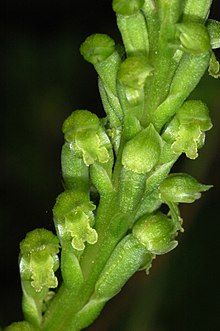| Microtis arenaria | |
|---|---|

| |
| In Mount Remarkable National Park | |
| Scientific classification | |
| Kingdom: | Plantae |
| Clade: | Tracheophytes |
| Clade: | Angiosperms |
| Clade: | Monocots |
| Order: | Asparagales |
| Family: | Orchidaceae |
| Subfamily: | Orchidoideae |
| Tribe: | Diurideae |
| Genus: | Microtis |
| Species: | M. arenaria |
| Binomial name | |
| Microtis arenaria Lindl. | |
| Synonyms | |
Microtis arenaria, commonly known as the notched onion orchid or pale onion orchid, is a species of orchid native to south-eastern Australia and New Zealand. It has a single hollow, onion-like leaf and up to sixty scented, crowded yellowish-green flowers. It is widespread and common, growing in a wide variety of habitats.
Description
Microtis arenaria is a terrestrial, perennial, deciduous, herb with an underground tuber and a single erect, smooth, tubular leaf 300–800 mm (10–30 in) long and 6–7 mm (0.2–0.3 in) wide. Between ten and sixty yellowish-green, fragrant flowers are crowded along a flowering stem 350–600 mm (10–20 in) tall. The flowers are 3–3.5 mm (0.12–0.14 in) long and 2–2.5 mm (0.08–0.1 in) wide. The dorsal sepal is egg-shaped, 2.5 mm (0.1 in) long and wide with its tip turned slightly upwards. The lateral sepals are 2.5 mm (0.1 in) long, about 1 mm (0.04 in) wide with their tips rolled under. The petals are lance-shaped but curved, about 2 mm (0.08 in) long, 1 mm (0.04 in) wide and are held under the dorsal sepal. The labellum curves downwards and is 2–2.5 mm (0.08–0.1 in) long, about 1.3 mm (0.05 in) wide with scalloped edges and a shallow notch at the tip between two prominent lobes. There is an irregularly-shaped callus in the centre of the labellum. Flowering occurs from September to January.
Taxonomy and naming
Microtis arenaria was first formally described in 1840 by John Lindley and the description was published in The Genera and Species of Orchidaceous Plants. The specific epithet (arenaria) is a Latin word meaning "sandy".
Distribution and habitat
The pale onion orchid is widespread and common in south-eastern New South Wales, throughout Victoria, Tasmania and south-eastern South Australia. It grows in a range of habitats from sandhills to rocky inland outcrops but is most common in coastal sand. Microtis arenaria also occurs on the North Island of New Zealand.
References
- ^ "Microtis arenaria". Australian Plant Census. Retrieved 11 January 2023.
- ^ Jones, David L. (2006). A complete guide to native orchids of Australia including the island territories. Frenchs Forest, N.S.W.: New Holland. pp. 222–223. ISBN 1877069124.
- ^ Jones, David L. (2021). A Complete Guide to Native Orchids of Australia (3rd ed.). Sydney: Reed New Holland. p. 394. ISBN 9781921517709.
- ^ Jeanes, Jeff. "Microtis arenaria". Royal Botanic Gardens Victoria. Retrieved 18 February 2018.
- "Microtis arenaria". APNI. Retrieved 18 February 2018.
- Lindley, John (1840). The gnera and species of orchidaceous plants. London: Ridgways. p. 396. Retrieved 18 February 2018.
- Brown, Roland Wilbur (1956). The Composition of Scientific Words. Washington, D.C.: Smithsonian Institution Press. p. 100.
- Jones, David L. (1998). "Contributions to Tasmanian orchidology". Australian Orchid Research. 3: 11.
- "Microtis arenaria". New Zealand Plant Conservation Network. Retrieved 13 January 2024.
- "Microtis arenaria". New Zealand Native Orchids. Retrieved 13 January 2024.
External links
- [REDACTED] Media related to Microtis arenaria at Wikimedia Commons